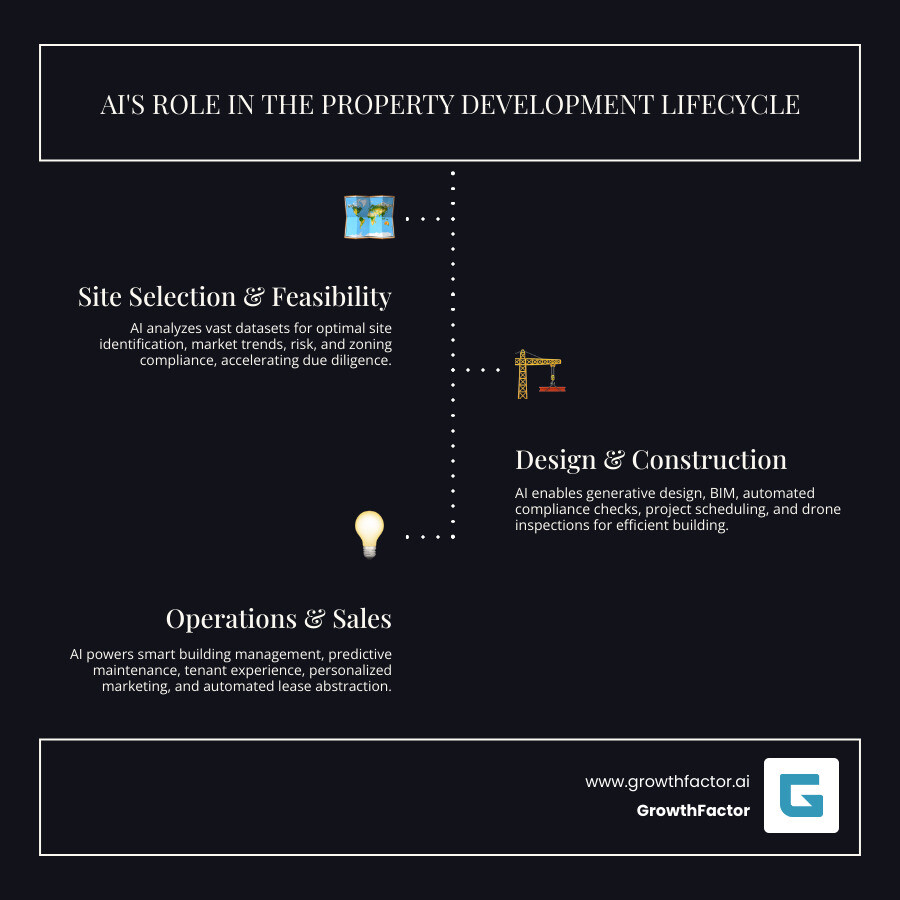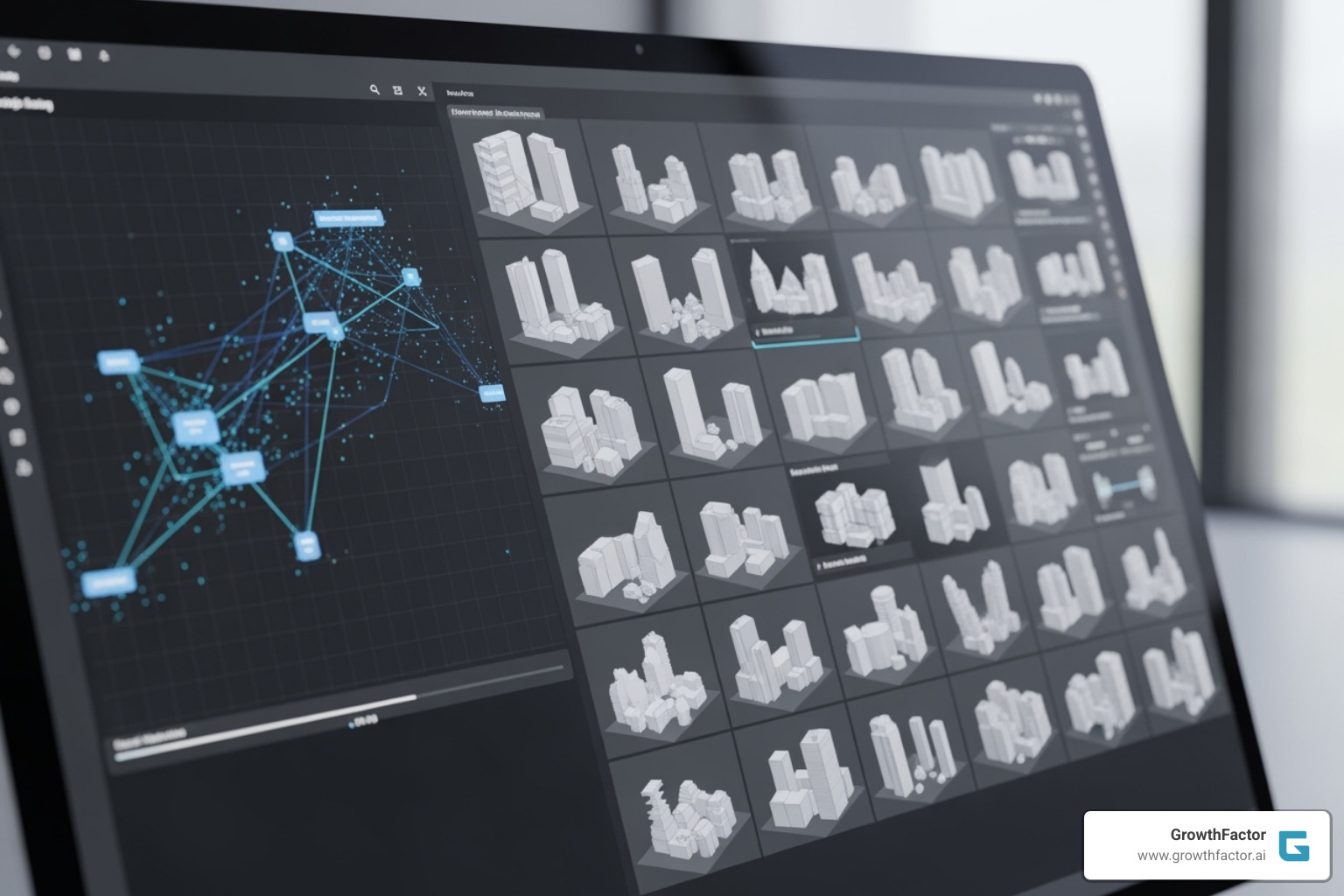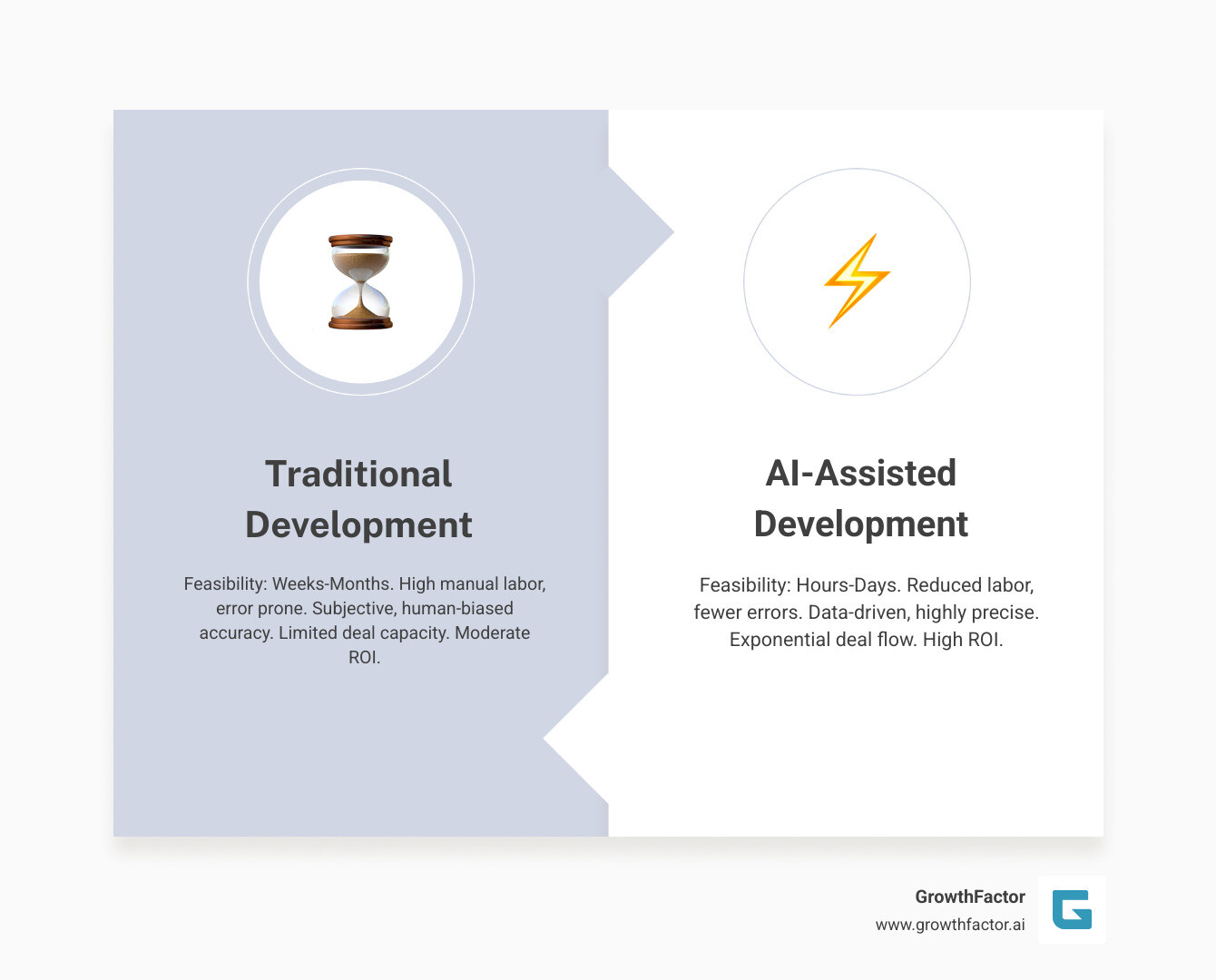From Blueprint to Brilliance: AI's Role in Modern Property Development
Stage 1: AI-Powered Site Selection and Feasibility Analysis

The world of real estate is changing fast, and AI for property development is leading the way. For those looking to understand its core impact quickly:
- What it is: AI in property development uses smart technology like machine learning to analyze vast amounts of data. This helps make better, faster decisions.
- Why it's growing: The property technology (Proptech) market is predicted to jump from $34 billion in 2023 to $90 billion by 2032. This shows how crucial AI is becoming.
- Key benefits: It drives huge gains in efficiency, cutting down time and costs. It also gives deeper, more accurate insights into properties and markets.
This powerful shift isn't just buzzwords. It's about practical tools redefining how we find, build, and manage properties. Traditionally, vetting new sites took weeks, if not months. Now, AI can quickly give you a "fast no" on a bad deal, or a confident "yes" on a great one. This saves huge amounts of wasted effort and opens doors to new opportunities. For example, our platform recently screened over 800 potential locations in less than 72 hours, a task that would have taken over 510 hours manually. This speed opens up real cash flow and revenue for our clients.
I'm Clyde Christian Anderson, CEO of GrowthFactor.ai. My background in investment banking and retail, combined with my MIT MBA, drives my passion for applying AI for property development to help growing retail brands succeed. At GrowthFactor, we focus on making real estate decisions faster and smarter, turning complex data into clear opportunities for our clients.

The journey of any successful property development begins with the right location. In the past, identifying that perfect spot was a painstaking process, relying on manual data collection and gut feelings. Enter AI, changing this crucial first stage into a data-driven science. AI in real estate development empowers us to analyze vast datasets, making site selection and feasibility studies not just faster, but incredibly precise.
Imagine sizing up a potential site in mere minutes, a task that once took weeks for initial drafts. With AI, site planning can be 4-10 times faster, allowing us to quickly evaluate dozens, even hundreds, of opportunities. This speed means we can find the hidden gems and avoid costly mistakes early on.

Uncovering Hidden Opportunities with Data Intelligence
Our AI-improved platforms act like super-detectives, sifting through mountains of data to uncover insights no human could process alone. We're talking about more than just looking at a map; we're diving deep into the very fabric of a location. This includes intricate demographic analysis, understanding residents' purchasing power and needs. We can map competitors, identifying where the market is saturated and where there's a clear opening.
Beyond static data, AI can interpret dynamic information like traffic patterns, predicting footfall and accessibility. It accurately estimates land values, considering myriad factors from zoning to recent sales, giving us a clear picture of potential returns. This level of Real Estate Data Intelligence allows us to make truly informed decisions, ensuring every choice is backed by solid evidence. The goal is to predict property value surges based on socio-economic indicators, infrastructure, and even global economic factors. Our Real Estate Market Analysis AI ensures we're always ahead of the curve.
Accelerating Due Diligence and Underwriting
Once a promising site is identified, the real work of due diligence begins. This phase, traditionally burdened with manual document sorting, is ripe for AI-driven change. AI automates data aggregation from countless sources, from property records to environmental reports, consolidating it into a digestible format.
For example, AI can process and analyze thousands of pages of zoning manuals in seconds, extracting key information that would take a human days or weeks to find. This means we can instantly understand zoning and rules, identifying potential issues or opportunities related to building codes, parking ratios, and environmental constraints like flood zones or wetlands.
In underwriting, AI shines by rapidly performing complex financial modeling and projecting ROI with unprecedented accuracy. It can run hundreds of scenarios, testing various development options against market conditions and cost estimates. This capability leads to what we affectionately call the "fast no" – the ability to quickly identify and discard non-viable deals, saving countless hours of manual work and non-billable hours. Our research shows that over $200k-$300k in non-billable hours can be saved by quickly vetting deals. This allows us to focus our precious resources on the most promising ventures, greatly improving our AI Real Estate Underwriting process.
Stage 2: Revolutionizing Design, Construction, and Compliance
With a promising site secured through AI analysis, it's time to bring your vision to life. This next stage—design, construction, and compliance—used to be a head-scratcher, filled with slow, manual tasks and errors. But AI for property development is changing that, making things smooth and efficient.
Designing Smarter, Not Harder
Think of generative design, powered by AI, as having an army of super-smart architects working for you, around the clock. Instead of a human designer sketching just a few ideas, AI can whip up hundreds of conceptual design options in mere minutes. It explores countless ways to make the most of your space, bring in natural light, and ensure everything works perfectly. You just tell it what you need – like the number of units, how much parking, or specific building rules – and AI instantly generates the best possible solutions.
This isn't just about creating pretty pictures. It's about ensuring your designs look good, follow all building codes, and truly maximize your site's potential. This quick, iterative process means you can test many ideas and instantly see the results. It allows us to explore two to three times more design options than with old methods. This speed is a huge advantage; AI can cut the time to create high-quality early designs by a whopping 30%. It also frees up our human architects to focus on the creative and strategic parts of the job, knowing AI has the heavy lifting of optimization and compliance covered. It’s no wonder that architecture firms ranked AI's potential for design options for conceptual/design development as their number one long-term use for this technology.
AI also plays a huge role in 3D modeling and Building Information Modeling (BIM). It can bring in environmental simulations, run material testing simulations, and even show how your project might impact the community. This lets us spot any potential issues or cool opportunities long before a single shovel hits the dirt. We can make adjustments right there on the screen, saving you time and money that would otherwise be spent fixing things on-site.
Streamlining Construction and Ensuring Safety
Beyond just design, AI for property development is making construction sites safer, more efficient, and much more predictable. It's brilliant at optimizing project scheduling, looking at countless details to create the smoothest timelines and even spotting potential delays before they happen. Resource allocation becomes a precise science, making sure materials and people are exactly where they need to be, right when they're needed. No more waiting around!
On-site, you'll find robotics becoming more common for jobs that are repetitive or a bit risky, like laying bricks or demolition. Drone inspections, powered by AI, can quickly check on progress, find any defects, and make sure everyone is following safety rules. Our platforms can even process drone imagery with AI to find weird patterns, predict when equipment might break down, and even plan for maintenance before it becomes an emergency. This proactive approach saves big on both time and money, and it seriously cuts down on risks.
AI is also a game-changer for supply chain management. By sifting through tons of data, it can guess demand, make logistics super efficient, and manage inventory much better. It’s no surprise that 40% of supply chain organizations are now investing in generative AI – they see its power to streamline operations and cut costs.
And let's not forget about compliance! This is another area where AI truly shines. Automated compliance checks against planning rules and local regulations are quickly becoming the norm. Instead of someone manually sifting through complex rulebooks, AI can instantly check your designs for adherence. It gives fast feedback, making sure your projects meet all the necessary legal and safety requirements right from the very beginning.
Stage 2: Revolutionizing Design, Construction, and Compliance
With a promising site secured through AI analysis, it's time to bring your vision to life. This next stage—design, construction, and compliance—used to be a head-scratcher, filled with slow, manual tasks and errors. But AI for property development is changing that, making things smooth and efficient.
Designing Smarter, Not Harder
Think of generative design, powered by AI, as having an army of super-smart architects working for you, around the clock. Instead of a human designer sketching just a few ideas, AI can whip up hundreds of conceptual design options in mere minutes. It explores countless ways to make the most of your space, bring in natural light, and ensure everything works perfectly. You just tell it what you need – like the number of units, how much parking, or specific building rules – and AI instantly generates the best possible solutions.
This isn't just about creating pretty pictures. It's about ensuring your designs look good, follow all building codes, and truly maximize your site's potential. This quick, iterative process means you can test many ideas and instantly see the results. It allows us to explore two to three times more design options than with old methods. This speed is a huge advantage; AI can cut the time to create high-quality early designs by a whopping 30%. It also frees up our human architects to focus on the creative and strategic parts of the job, knowing AI has the heavy lifting of optimization and compliance covered. It’s no wonder that architecture firms ranked AI's potential for design options for conceptual/design development as their number one long-term use for this technology.

AI also plays a huge role in 3D modeling and Building Information Modeling (BIM). It can bring in environmental simulations, run material testing simulations, and even show how your project might impact the community. This lets us spot any potential issues or cool opportunities long before a single shovel hits the dirt. We can make adjustments right there on the screen, saving you time and money that would otherwise be spent fixing things on-site.
Streamlining Construction and Ensuring Safety
Beyond just design, AI for property development is making construction sites safer, more efficient, and much more predictable. It's brilliant at optimizing project scheduling, looking at countless details to create the smoothest timelines and even spotting potential delays before they happen. Resource allocation becomes a precise science, making sure materials and people are exactly where they need to be, right when they're needed. No more waiting around!
On-site, you'll find robotics becoming more common for jobs that are repetitive or a bit risky, like laying bricks or demolition. Drone inspections, powered by AI, can quickly check on progress, find any defects, and make sure everyone is following safety rules. Our platforms can even process drone imagery with AI to find weird patterns, predict when equipment might break down, and even plan for maintenance before it becomes an emergency. This proactive approach saves big on both time and money, and it seriously cuts down on risks.
AI is also a game-changer for supply chain management. By sifting through tons of data, it can guess demand, make logistics super efficient, and manage inventory much better. It’s no surprise that 40% of supply chain organizations are now investing in generative AI – they see its power to streamline operations and cut costs.
And let's not forget about compliance! This is another area where AI truly shines. Automated compliance checks against planning rules and local regulations are quickly becoming the norm. Instead of someone manually sifting through complex rulebooks, AI can instantly check your designs for adherence. It gives fast feedback, making sure your projects meet all the necessary legal and safety requirements right from the very beginning.
The Financial Blueprint: ROI of AI for Property Development
When bringing new technology into property development, one question always comes up: does it make financial sense? Does it save money or help us make more? For AI for property development, the answer is a clear yes to both!
This powerful technology translates directly into significant cost savings and a boost in revenue. By automating those time-consuming tasks, making everything more efficient, and helping us make faster, more accurate decisions, AI cuts down on operating costs across the board. This isn't just about saving a few bucks; it gives us a serious competitive edge. Developers can move quicker, bid smarter, and ultimately, secure more deals. In fact, our clients using AI have seen incredible results, like winning an extra $750,000 in project fees, thanks to the speed and precision AI brings to the table.
Calculating the Return on AI Investment
The return on investment (ROI) from embracing AI for property development can truly be staggering. We've already seen how AI can save hundreds of thousands of dollars in non-billable hours, simply by letting us vet deals much faster. But let's take a broader look at how AI transforms the entire development process:
| Metric | Traditional Development Workflow | AI-Assisted Development Workflow |
|---|---|---|
| Time | Weeks to months for feasibility | Hours to days for feasibility |
| Cost | High manual labor, potential errors | Reduced labor, fewer errors |
| Accuracy | Subjective, prone to human bias | Data-driven, highly precise |
| Deal Flow | Limited by manual capacity | Exponentially increased |
| ROI Potential | Moderate, reactive | High, proactive |

While there's certainly an initial investment involved in integrating AI platforms, the long-term value quickly proves its worth. This isn't just about cutting expenses; it's about growing your income. AI significantly increases your "deal flow" because you can evaluate so many more opportunities than you could before. It also boosts your portfolio's performance by helping you pinpoint the best investment strategies and manage properties with far greater efficiency. For those of us in retail real estate, this means finding those absolutely perfect locations for our brands, maximizing their exposure and profitability.
At GrowthFactor, we truly understand that every investment you make needs to deliver real value to your bottom line. That's why we've designed our plans to fit various needs and budgets. Our Core plan starts at just $500, giving you essential AI tools to get started. If you're looking for more comprehensive features and deeper insights, our Growth plan is available at $1,500. And for larger operations with unique requirements, we offer custom Enterprise plans. This ensures you get precisely the tools you need to maximize your return on investment in Real Estate Investment AI and effectively manage your Commercial Real Estate Portfolio Management.
Navigating the Challenges and Future Landscape
While the benefits of AI for property development are clear, it's important to approach this technology understanding its challenges and ethical considerations. Like any transformative tool, AI comes with responsibilities.
Ethical Considerations and Responsible AI
One of the primary concerns is data privacy. AI systems thrive on data, and in real estate, this often includes sensitive information about properties, markets, and even individuals. Ensuring robust data governance, transparency in how data is collected and used, and strict adherence to privacy regulations is paramount. We must be diligent in safeguarding this information.
Another critical ethical consideration is algorithmic bias. If the data used to train AI models contains historical biases (e.g., in lending or property valuations), the AI might perpetuate them. This could lead to unfair outcomes or missed opportunities. Mitigating bias in datasets requires careful curation and continuous monitoring. This is no small feat; poor data quality costs the U.S. economy around $3.1 trillion per year. A "human-in-the-loop" approach, where human experts oversee and validate AI outputs, is crucial to ensure fairness and accuracy. This commitment to responsible AI is being recognized at the highest levels, with President Biden issuing an executive order on the safe, secure, and trustworthy development and use of artificial intelligence that sets clear guidelines for ethical implementation.
Finally, we must acknowledge AI's environmental impact. Training and running complex AI models require significant computing power and energy consumption. For example, Google’s greenhouse gas emissions increased 48% over the last five years due to AI integration. Even generating a 100-word email with ChatGPT requires the equivalent of one bottle of water to cool its servers. As AI becomes more prevalent, the demand for data center power is projected to increase 160% by 2030, necessitating massive investments in new power generation infrastructure. This is a challenge we, as an industry, must collectively address through sustainable practices and energy-efficient AI development.
Frequently Asked Questions about AI in Property Development
You've seen how AI for property development is changing the lifecycle. But you might have questions about how it works in practice. Let's explore some common ones.
How does AI help in identifying profitable development sites?
Think of AI as your super-smart detective for real estate. It can sift through mountains of information—things like local zoning laws, the latest demographic trends, detailed market data, and even environmental factors—all in the blink of an eye. This helps it predict a site's potential for profitability with incredible speed and accuracy.
Traditional methods rely on human analysts, who are brilliant but can only process so much at once. AI, on the other hand, can crunch millions of data points simultaneously. It spots patterns and connections that might be invisible to the human eye, allowing you to uncover those hidden gems and assess risks much more effectively. This process significantly speeds up and improves the accuracy of your real estate site selection.
Can AI replace architects and developers?
This is a common question, and the simple answer is no! We like to think of AI as an incredibly powerful "co-pilot." It's here to boost human expertise, not take its place. Imagine having an assistant that can handle all the repetitive, time-consuming tasks.
That's what AI does for architects and developers. It automates things like deep data analysis, generating initial design ideas, and running through endless compliance checks. This frees up human professionals to focus on what they do best: the strategic thinking, the creative design, and tackling the truly complex, nuanced problems that only human ingenuity can solve. The magic really happens when you blend human intuition with AI's analytical muscle; together, they create a workflow that's far more efficient and innovative than either could achieve alone.
What are the first steps to integrating AI into a development firm?
Ready to jump in? The best way to start integrating AI for property development into your firm is by looking inward first. Identify the specific areas in your current workflow that cause the most headaches. Are there manual processes that are incredibly time-consuming or prone to errors, like initial site analysis or feasibility studies? These are your "pain points" and often the best places to begin.
Once you know where you need help, start exploring specialized AI platforms that are designed to solve those exact problems. For AI to work its magic, it needs good information, so developing a robust data strategy is key. This means ensuring your data is clean, organized, and easily accessible for the AI to learn from.
Finally, don't try to change everything at once. Begin with a smaller "pilot project" to test the waters. This allows you to measure the impact, demonstrate a clear return on investment, and build confidence before you scale AI across your entire organization. And remember, successful adoption isn't just about the tech; it's also about training your team on how to effectively collaborate with these new AI tools. It's a partnership, and a powerful one at that!
Conclusion: Building the Future with Intelligence
We've explored how AI for property development is revolutionizing the real estate world. From the initial idea for a new site to the daily operations of a thriving property, AI is making its mark at every stage.
Think back to how it all begins: finding that perfect piece of land and making sure it's a solid investment. Then, moving into the creative design phase, making sure our buildings are not just beautiful but also super efficient and compliant. And finally, managing those properties, keeping tenants happy, and making sure everything runs smoothly. AI isn't just a helper; it's becoming an essential partner in all of these steps.
The magic of AI really lies in two big things: incredible efficiency and smart, data-driven decisions. It lets us move at a pace that was simply unthinkable before, allowing us to check out more deals, fine-tune designs, and manage properties with insights that used to feel like science fiction. This isn't just about doing things faster; it's about doing them much smarter, with more accuracy, and with a far deeper understanding of what the market truly needs.
So, what does the future hold for real estate? It’s not about machines taking over our jobs. Instead, it's about a powerful, dynamic partnership between human smarts and machine intelligence. AI handles all the heavy lifting of crunching numbers and doing repetitive tasks. This frees us up to do what we do best: innovate, think strategically, and build those crucial relationships.
Here at GrowthFactor, we're incredibly passionate about giving retail real estate developers like you the very best tools to thrive in this new era. We believe in using the power of AI for property development to help you evaluate sites with best speed and pinpoint accuracy. Ready to see the difference? We invite you to explore the GrowthFactor All-in-One Real Estate Platform. Let's build the future, together!
Citations
The human algorithm
Request Your demo
Schedule meeting
Or submit your information below and we'll be in touch to schedule.


